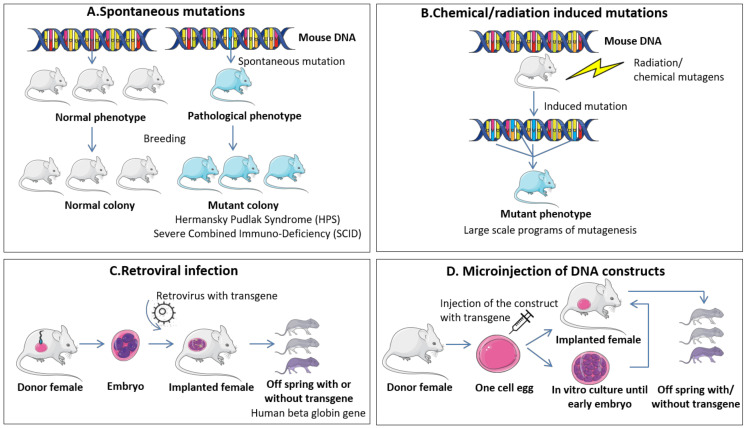Cancer research needs a thorough understanding of the relationship between neoplastic cells and host immunity, the tumor microenvironment, the complex molecular signaling pathways, and so on. Mouse models of human cancer have contributed considerably to our knowledge of the dual role of the immune system in oncogenesis and tumor progression. In this article, we briefly introduce the spontaneous and induced mouse tumor models.
A type of tumor that occurs naturally without conscious artificial experimental treatment is called a spontaneous tumor and is generally caused by spontaneous mutations. Some inbred mouse strains show a tendency to develop spontaneous cancers with a high probability, resulting in a series of spontaneous cancer mouse models, such as breast cancer, leukemia, and liver cancer mouse models. The occurrence and development of tumors in spontaneous mouse cancer models are highly similar to those in humans. We can use it to study the relationship between genetic factors and tumorigenesis. Moreover, researchers have established many tumor cell lines (such as colon cancer cells, melanoma cells, hepatocellular carcinoma cells, lymphoma cells, etc) from spontaneous mouse tumors that can be cultured and passaged in vitro. These tumor cell lines not only provide tools for in vitro biological research on cancer cells but also can be transplanted into genetic backgrounds. A mouse model of transplanted tumors was established in other mice that were identical and would not undergo immune rejection. However, the occurrence of tumors is uneven, the cycle is long, and experiments are expensive.
 Fig.1. Methods for generation of spontaneous and induced mouse tumor models.1,2
Fig.1. Methods for generation of spontaneous and induced mouse tumor models.1,2
Induced mouse tumor models refer to experimental mouse tumor models induced by chemical carcinogens and environmental factors, such as hormones, diet, chemical carcinogens, radiation, and oncogenic viruses. There are already several different kinds of carcinogens that have been used in inducting oncogenesis in mice. For example, many research achievements have been carried out by painting chemical carcinogens to the skin of mice, thereby inducing the formation of local tumors that can be easily monitored. Exposure to DNA-damaging agent 7, 12-dimethylbenzanthracene (DMBA) plus UV light or phorbol ester 12-O-tetradecanoylphorbol-13-acetate (TPA) induces melanomas or papilloma, which may evolve into squamous cell carcinomas, even in immunocompetent mice. Infection of some oncogenic viruses, such as murine sarcoma virus (MSV), murine leukemia viruses (MLVs), murine polyomavirus (MPYV), and mouse mammary tumor virus (MMTV), can directly cause or promotes the development of various cancers in mice.
The advantage of the induced mouse cancer model is:
But at the same time, the disadvantages are long induction time costs and relatively high animal mortality. These tumors are genetically diverse and highly heterogeneous in terms of onset, progression, histology, and antigenic composition.
Creative Biolabs provides excellent services and relevant experimental techniques in the construction and research of spontaneous and induced mouse tumor models for immune checkpoints. If you are looking for a reliable, high-quality, and customized research partner, I highly recommend contacting us for support. Our comprehensive and customizable services for worldwide customers include but are not limited to:
References
All listed customized services & products are for research use only, not intended for pharmaceutical, diagnostic, therapeutic, or any in vivo human use.
USA
Tel:
Fax:
Email:
Copyright © 2025 Creative Biolabs. All Rights Reserved.